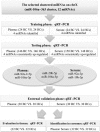Circulating microRNAs from the miR-106a-363 cluster on chromosome X as novel diagnostic biomarkers for breast cancer
- PMID: 29557526
- PMCID: PMC5999170
- DOI: 10.1007/s10549-018-4757-3
Circulating microRNAs from the miR-106a-363 cluster on chromosome X as novel diagnostic biomarkers for breast cancer
Abstract
Purpose: Novel noninvasive biomarkers with high sensitivity and specificity for the diagnosis of breast cancer (BC) are urgently needed in clinics. The aim of this study was to explore whether miRNAs from the miR-106a-363 cluster can be detected in the circulation of BC patients and whether these miRNAs can serve as potential diagnostic biomarkers.
Methods: The expression of 12 miRNAs from the miR-106a-363 cluster was evaluated using qRT-PCR in 400 plasma samples (from 200 BC patients and 200 healthy controls (HCs)) and 406 serum samples (from 204 BC patients and 202 HCs) via a three-phase study. The identified miRNAs were further examined in tissues (32 paired breast tissues), plasma exosomes (from 32 BC patients and 32 HCs), and serum exosomes (from 32 BC patients and 32 HCs).
Results: Upregulated levels of four plasma miRNAs (miR-106a-3p, miR-106a-5p, miR-20b-5p, and miR-92a-2-5p) and four serum miRNAs (miR-106a-5p, miR-19b-3p, miR-20b-5p, and miR-92a-3p) were identified and validated in BC. A plasma 4-miRNA panel and a serum 4-miRNA panel were constructed to discriminate BC patients from HCs. The areas under the receiver-operating characteristic curves of the plasma panel were 0.880, 0.902, and 0.858, and those of the serum panel were 0.910, 0.974, and 0.949 for the training, testing, and external validation phases, respectively. Two overlapping miRNAs (miR-106a-5p and miR-20b-5p) were consistently upregulated in BC tissues. Except for the expression of the plasma-derived exosomal miR-20b-5p, the expression patterns of exosomal miRNAs were concordant between plasma and serum, indicating the potential use of exosomal miRNAs as biomarkers.
Conclusion: We identified four plasma miRNAs and four serum miRNAs from the miR-106a-363 cluster as promising novel biomarkers for the diagnosis of BC.
Keywords: Breast cancer; Circulating microRNA; Diagnosis; Exosomes; qRT-PCR.
Conflict of interest statement
Ethics approval
All procedures were approved by Institutional Review Boards of the First Affiliated Hospital of Nanjing Medical University.
Informed consent
Written informed consent was obtained from patients involved in the study.
Figures






Similar articles
-
Identification of non-invasive biomarkers for chronic atrophic gastritis from serum exosomal microRNAs.BMC Cancer. 2019 Feb 8;19(1):129. doi: 10.1186/s12885-019-5328-7. BMC Cancer. 2019. PMID: 30736753 Free PMC article.
-
MicroRNA profiling in serum: Potential signatures for breast cancer diagnosis.Cancer Biomark. 2021;30(1):41-53. doi: 10.3233/CBM-201547. Cancer Biomark. 2021. PMID: 32894240
-
A serum exosomal microRNA panel as a potential biomarker test for gastric cancer.Biochem Biophys Res Commun. 2017 Nov 25;493(3):1322-1328. doi: 10.1016/j.bbrc.2017.10.003. Epub 2017 Oct 3. Biochem Biophys Res Commun. 2017. PMID: 28986250
-
Are circulating microRNAs peripheral biomarkers for Alzheimer's disease?Biochim Biophys Acta. 2016 Sep;1862(9):1617-27. doi: 10.1016/j.bbadis.2016.06.001. Epub 2016 Jun 2. Biochim Biophys Acta. 2016. PMID: 27264337 Free PMC article. Review.
-
MicroRNAs: New Biomarkers for Diagnosis, Prognosis, Therapy Prediction and Therapeutic Tools for Breast Cancer.Theranostics. 2015 Jul 13;5(10):1122-43. doi: 10.7150/thno.11543. eCollection 2015. Theranostics. 2015. PMID: 26199650 Free PMC article. Review.
Cited by
-
Exosomal microRNA-92b Is a Diagnostic Biomarker in Breast Cancer and Targets Survival-Related MTSS1L to Promote Tumorigenesis.Int J Mol Sci. 2024 Jan 20;25(2):1295. doi: 10.3390/ijms25021295. Int J Mol Sci. 2024. PMID: 38279296 Free PMC article.
-
A five-miRNA panel in plasma was identified for breast cancer diagnosis.Cancer Med. 2019 Nov;8(16):7006-7017. doi: 10.1002/cam4.2572. Epub 2019 Sep 30. Cancer Med. 2019. PMID: 31568692 Free PMC article.
-
The dual role of microRNA (miR)-20b in cancers: Friend or foe?Cell Commun Signal. 2023 Jan 30;21(1):26. doi: 10.1186/s12964-022-01019-7. Cell Commun Signal. 2023. PMID: 36717861 Free PMC article. Review.
-
Addressing the Clinical Feasibility of Adopting Circulating miRNA for Breast Cancer Detection, Monitoring and Management with Artificial Intelligence and Machine Learning Platforms.Int J Mol Sci. 2022 Dec 6;23(23):15382. doi: 10.3390/ijms232315382. Int J Mol Sci. 2022. PMID: 36499713 Free PMC article. Review.
-
miR-1275 targets MDK/AKT signaling to inhibit breast cancer chemoresistance by lessening the properties of cancer stem cells.Int J Biol Sci. 2023 Jan 1;19(1):89-103. doi: 10.7150/ijbs.74227. eCollection 2023. Int J Biol Sci. 2023. PMID: 36594100 Free PMC article.
References
MeSH terms
Substances
Grants and funding
LinkOut - more resources
Full Text Sources
Other Literature Sources
Medical
Molecular Biology Databases

